In the week commencing 14 September 1970, Edward Heath was in residence in 10 Downing Street, Tears of a Clown by Smokey Robinson and the Miracles was top of the charts, back and white television sets were still in higher demand than the newly introduced colour sets, and one hundred pounds back then would now (in 2023) have the purchasing power of around £1,900.
Meanwhile, the newspapers rocked the music scene with reports of the shocking death of the brilliant young guitarist Jimi Hendrix, as a result of a barbiturate overdose on 18 September 1970. The ‘Twenty-Seven Club’ had claimed its latest casualty. The following day, festival goers (all 1,500 of them) were heading to Worthy Farm for the first time, no doubt eagerly anticipating the extra jam session by Marsupilami (whatever happened to them?). If the audience behaved themselves they’d come back and do it all again on Sunday. With free milk. I wonder if it’s still going.
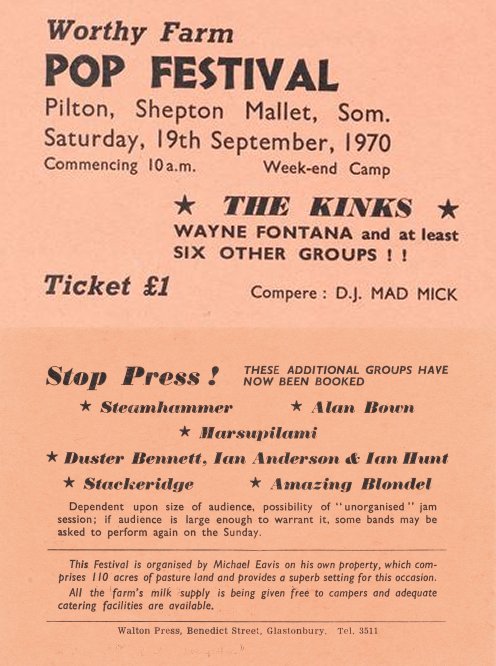
But before the fun-packed weekend, this was the week that Everton were participating the European Champions Cup for only the second time in their history, after their place was confirmed on April Fool’s Day 1970, when goals from Alan Whittle and Colin Harvey secured their passage into Europe’s top club competition. (Their previous encounter was in 1963/64).
When the draw for Europe’s elite took place, the English champions were paired with the Icelandic part-timers Knattsoyrnudild Keflavik, known to us simply as Keflavik, with the first leg played at Goodison Park. Keflavik were also tasting the big European challenge for the second time in their history too, their first foray being in 1965/66.
In the run up to the tie, Everton’s league form had been very disappointing, with only two wins and three draws out of the eight games played thus far. Home form, coupled with the fact that many looked upon Keflavik as lowly opposition in the early stages of the competition, contributed to a meagre 28,444 fans turning out to witness this special occasion on a September evening.
The front page of the match-day programme displayed an image of the Everton team proudly showing the trophy sitting in front of manager Harry Catterick. On page three, there was a message in Icelandic that read; “Vid bjodum leikmenn forystumeenn og ahangendur keflavikur velkomma a leikvang Everton, Goodison Park, i vold” ;- “We welcome players and fans to Everton’s stadium, Goodison park.”

Everton v Keflavik – 16 September 1970
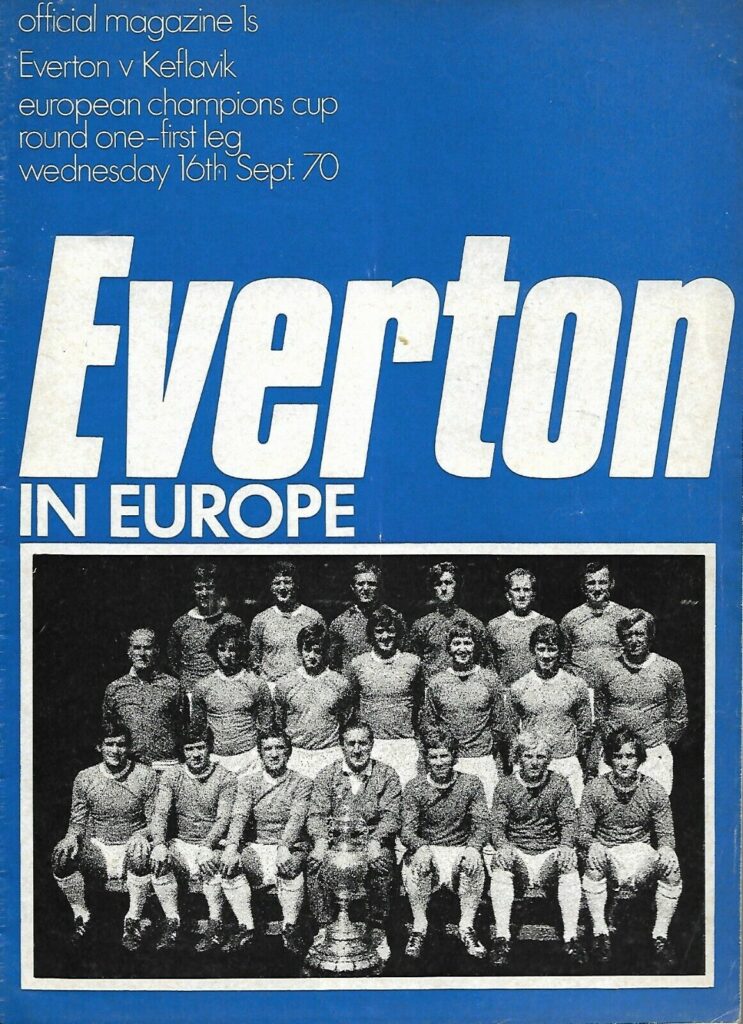
With the blow of the whistle from Cypriot Michalakis Kiriakides, Everton’s European Cup campaign was underway.
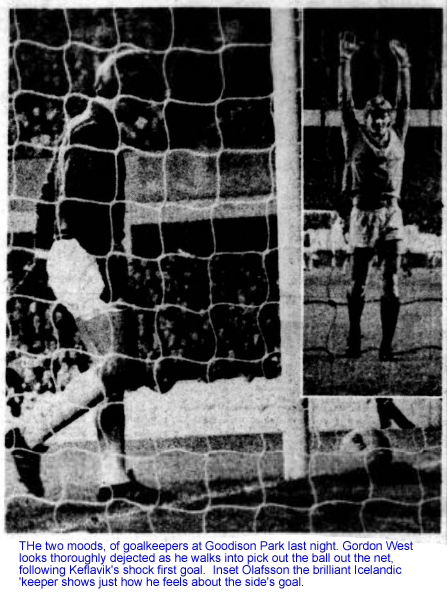
It didn’t take long for Everton’s league form to hang like a spectre over the silent crowd when Gordon West put through his own net after only eleven mintures. Thankfully, the aberration was brief, and the Toffees led 2-1 at the break.
A further four second half goals, plus a late consolation from the visitors, ended the tie with a comfortable 6-2 cushion.

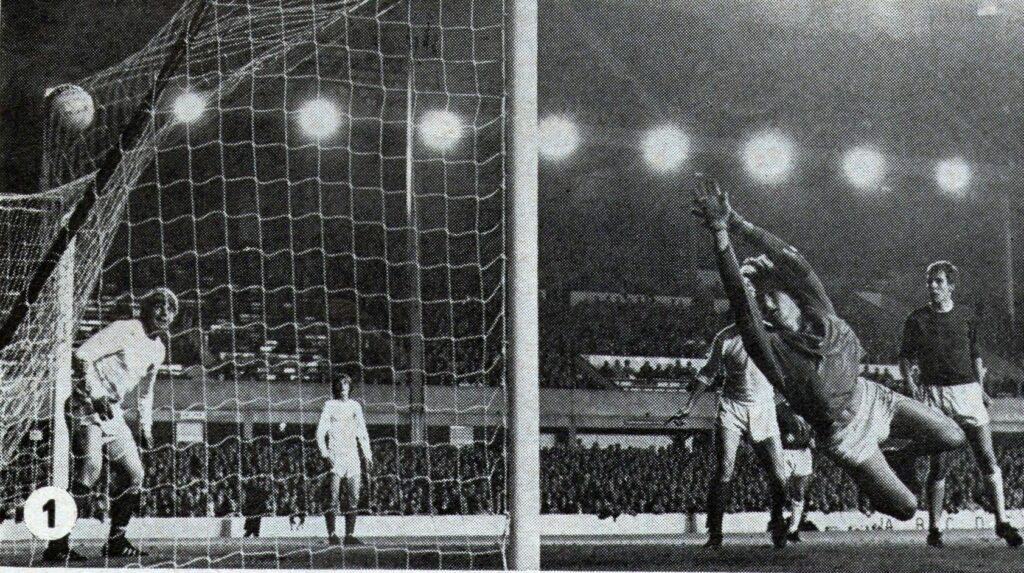
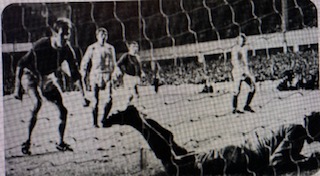
Watch all the goals here;
Keflavik v Everton – 30 September 1970
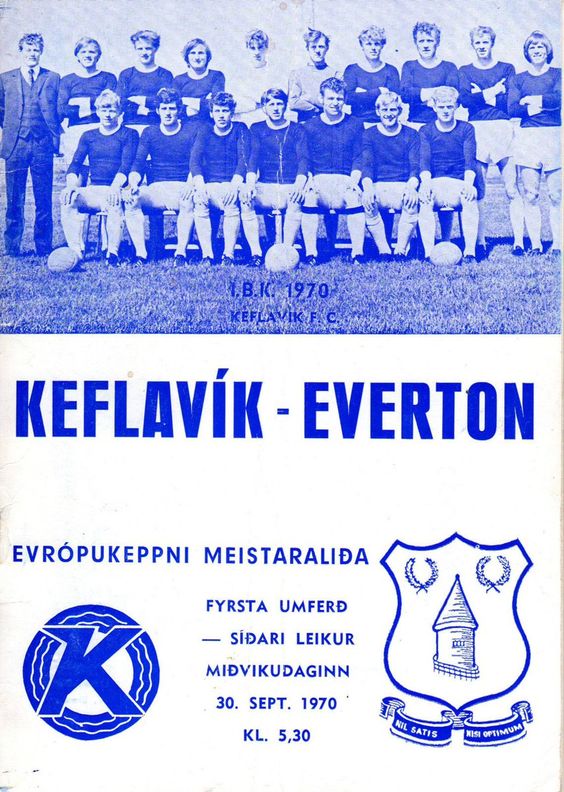
The return leg took place fourteen days later at Laugardalsvollur Stadium in Reykjavik.
The reason for the change in venue was because it was considered more profitable with the city having a population of 90,000, compared with Keflavik’s 5,500. In total, Iceland had a population of 200,000 and an average league attendance of 1,500.
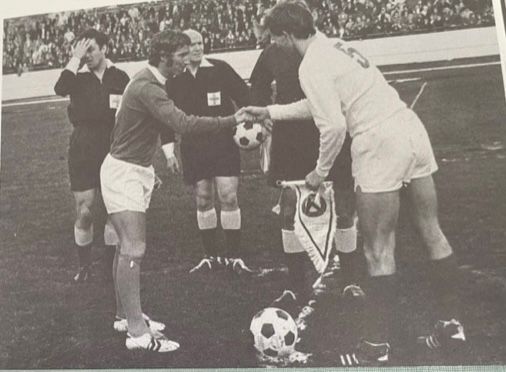
Everton made three changes from the first leg, with Andy Rankin replacing Gordon West in goal; Brian Labone was reinstated, taking over from Roger Kenyon; and Alan Whittle took over the number seven shirt from Jimmy Husband, while the home side remained unchanged.
A shock win for the home side was never on the cards, especially after the 9,546 crowd saw the visitors score two first half goals, with a third added just one minute after the break. There was no coming back from a 2-9 deficit in favour of the Blues.
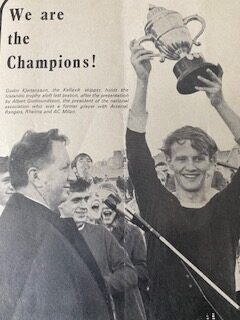
Ástráður Gunnarsson wore the number three shirt. He was, no doubt, very loyal to Keflavik, spending eight years making seventy-four appearances. He also represented his country on eight occasions between 1973-1974.
Gudni Kjartansson, was Keflavik’s big, tall centre half. His love affair with the club spanned thirteen years, during which time he was also capped thirty-one times for his country. Gudni is a sports teacher by profession, has a KSI-A coaching degree, and is, without doubt, one of the most experienced coaches in Icelandic football. He has managed most of Iceland’s national teams, including the men’s A national team, in addition to managing the U19 men’s national team for several years. Gudni was chosen as Sportsman of the Year in 1973, the first footballer to earn the acolade. He played thirty-one A-national games for Iceland during 1967-73, captaining his country in seven of those games.
………………………………………………………………….

I am pleased to bring to you the thoughts of these Icelandic legends and to share their experiences of the games against Everton all those years ago.
From the outset, both men preferred to have had an English club as opposition in the first round, especially as it would bring more excitment to the occasion. English football was always of interest to overseas countries, so Gudni saw a lot of Everton on TV in Iceland and Everton were no strangers to them.
Could the part timers cope with the professionals from England, and how much of a difference in level was there between the two teams?
Ástráður openly admits; “The gulf between the sides was vast because its difficult for players in the game who play part time, while also having full time jobs. It’s always going to be an issue when you are put to the test against professional athletes.”
Equally the captain’s thoughts were very similar; “There was a big difference as everyone on the Icelandic teams were amateurs, working or studying all day, then training in the evening, whereas English teams were playing professionally. That eventually showed over the games between us.”
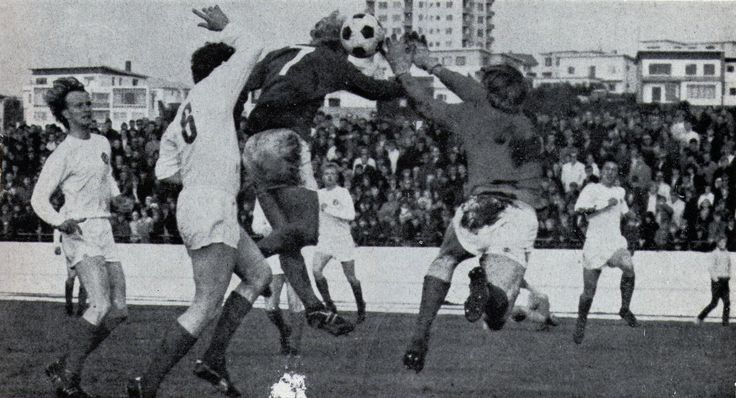
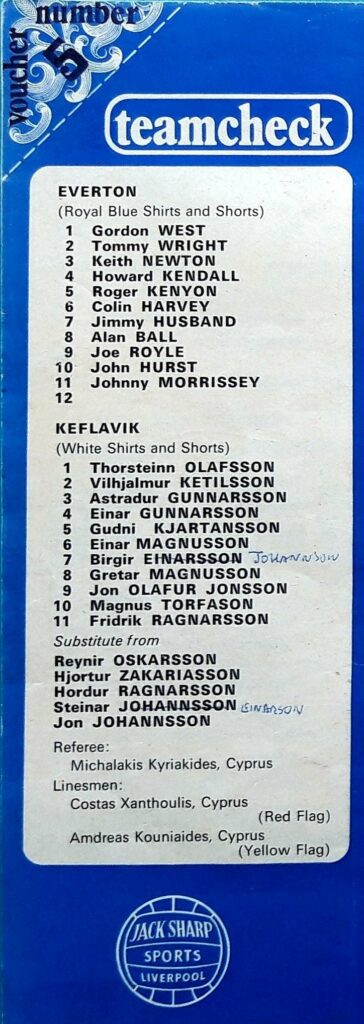
Ástráður was also clued-up on the English champions, and was well aware of the threat that they would pose. Where would the danger come from, and what players would be the ones to watch out for?
Gudni replied; “I saw Joe Royle as the biggest danger as I played centre half myself. Alan Ball, Keith Newton, Tommy Wright and Brian Labone were involved with their country months earlier for England in the Mexico World Cup. Howard Kendall, albeit not involved in the world tournament, was also a player known to us.
Used to playing in front of very small crowds in their own stadium back home in Keflavik, Goodison Park, with its new Main Stand construction, impressed club captain Gudni and his colleagues. The atmosphere was another experience, which also added flavour on the night, as both were well aware that the famous old stadium had been used just four years earlier for the World Cup, where the greats such as Eusebio, Franz Beckenbauer, Pele, Yashin and Florian Albert had graced the turf.
Gordon West was credited with an own goal for the Keflavik opener. Gudni recalled, “We were delighted when we scored against Everton, but we were a bit lucky. I was realistic,as I knew that Everton had a much better side. The whole evening was such a fantastic experience; to have been able to play against such great players at such a big stadium. Also, it was a great gesture from the club itself, as we felt very welcome as guests.”
Ástráður added that the goal was something of a shock. “The early lead was least expected which led a response of boos from the home crowd.”
However, the Blues calmed the nerves of the home crowd by going 2-1 up at the break, before jogging into a canter in the second half, adding four more goals. A consolation goal for the Icelanders was added twelve minutes before the full-time whistle.
Gudni; “Naturally the first leg was won by the favourites, and yes, you are always disappointed when you lose, but this was a deserved victory and Everton were the much better side.”
Everton were heading into the return leg with a comfortable four-goal cushion. Did the part-timers believe it could be possible to take home advantage on their soil, despite the game being played in Reykjavik, 29 miles from their stadium?
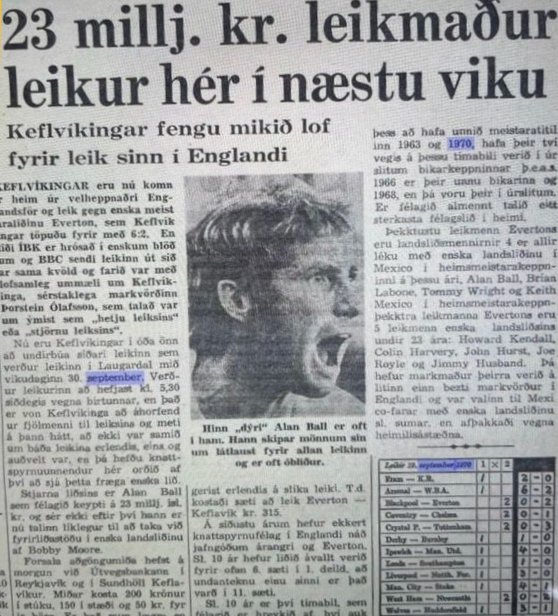
Gunnarsson replied; “We knew that four goals were a lot to chase, especially against tough opposition, while Kjartansson added; “We assumed it would be very difficult to win the second leg despite it being in Iceland, such was the quality of the Everton side.”
The second leg failed to produce an upset, as Alan Whittle gave the visitors a lead just after half an hour. A penalty was awarded to Everton on thirty-eight minutes, with Joe Royle stepping up to take the kick. Olafsson in the Keflavik goal saved the kick, allowing Joe fortuitously to score from the rebound, notching his seventh goal of the season. Sixty seconds after the restart, Royle added another goal, to make the aggregate score 9-2 to the English champions.
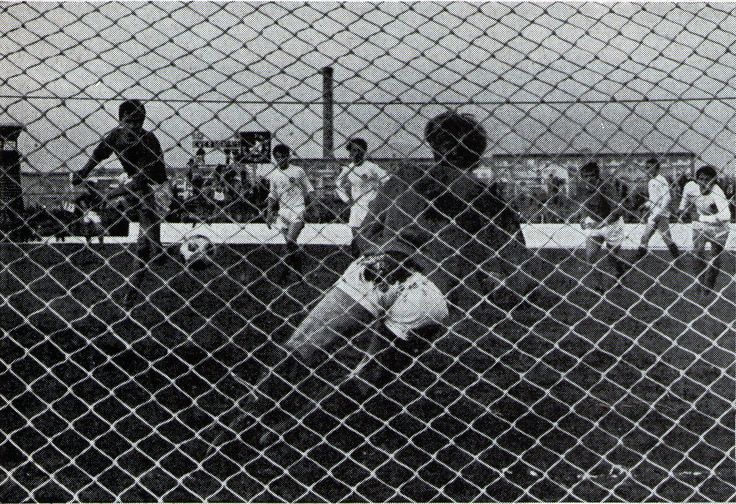
Did the players of Keflavik feel too disappointed with the outcome over the two games?
Gunnarsson said; “We felt satisfied with our performance, if that makes sense, for the reasons that’s been mentioned previously. Nobody gave us a chance, therefore what did we have to lose?”
The captain also shares his opinion; “We weren’t pleased to lose, who likes to lose? But its not a nice experience to lose by a large deficit, but that scoreline was more normal between two sides from different levels and the outcome to be expected. “
………………………………………………………………….
Once Everton confirmed their passage into the next round, they faced tougher opposition against German champions Borussia Monchengladbach, who stood in their way of a place in the quarter-final stage of the competition.
Everton took comfort from a draw in the away leg at the Bokelberg stadium situated on the north Rhein-Westphalia. However, the return leg could not be decided in normal time, and even with an additional thirty minutes of extra time, the game could only be decided on penalties.
History was in the making when the hero of the hour, goalkeeper Andy Rankin, saved the last kick from Ludwig Muller – which made him the first keeper to save a penalty in a European competition.

Victory paired them with the legendary Ferenc Puskas side Panathinaikos in the quarter-final. A goal for the visitors from Antonis Antoniadiseight minutes from time, proved to be priceless, but despite a late equaliser from Everton’s David Johnson, the Blues needed to win away from home to reach the next stage. The second leg drew a blank and the Blues’ campaign was dead.
So, what were the thoughts of my guests Gunnarsson and Kjartansson on Everton’s progress in the competition? Gunnarson says; “I didn’t so much follow their progress because English/British teams were always going to be a force in Europe. Celtic and Manchester United proved that with their successes in 1967 and 1968 respectively. So, I wasn’t surprised that Everton got to the latter stages.”
Kjartansson replied; “I didn’t follow their progress in the competition but I assumed they would go far as they were one of the top sides from England.”
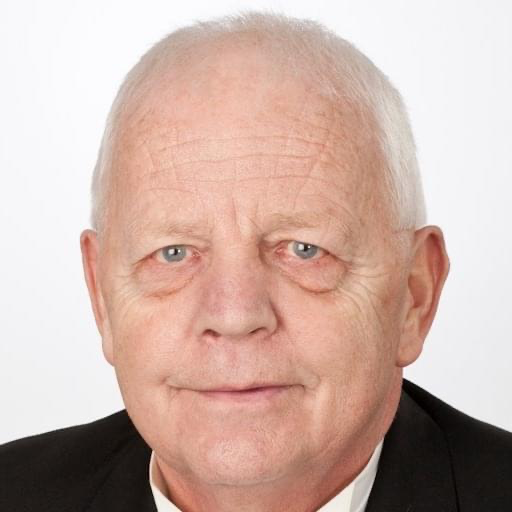
Finally, on their brief stay in the city, what did the Icelandic champions do in their leisure time?
Gunnarsson remembers clearly;” A city excursion wasn’t necessary, but I was aware of the attractions and why the city brought so many people to the area. Not only did it have two good football teams, the music was equally important”
Kjartansson replied; “We didn’t go sightseeing, but we were very interested in The Beatles and visited some historical places related to them in downtown Liverpool. I actually know Liverpool very well, as I visited the city very frequently while my son played for Liverpool and lived at the Albert Dock.”
…………………………………………………………….



